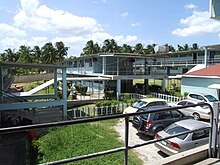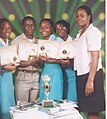
Naparima College is a public secondary school for boys in Trinidad and Tobago. Located in San Fernando, the school was founded in 1894 but received official recognition in 1900. It was established by Dr. Kenneth J. Grant, a Canadian Presbyterian missionary working among the Indian population in Trinidad. The school was one of the first to educate Indo-Trinidadians and played an important and crucial role in the development of an Indo-Trinidadian and Tobagonian professional class. Naparima is derived from the Arawak word (A) naparima, meaning ‘large water’, or from Nabarima, Warao, for ‘Father of the waves.’
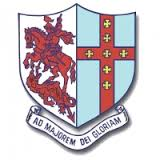
St. George's College is a public Catholic secondary school, located in Kingston, Jamaica. The school was founded by the Society of Jesus in 1850. It was established by 21 Spanish Jesuits who had been exiled from Colombia as part of a religious persecution. Initially founded as a school for boys only, in 2005 the College opened its pre-university programme to female students.
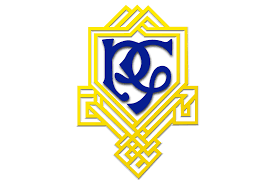
Presentation College San Fernando is a selective, government-assisted Roman Catholic Boys’ Secondary School located in San Fernando, Trinidad and Tobago. It claims to be the first Catholic secondary school in South Trinidad, having been established around 1930 in the basement of San Fernando Presbytery. It relocated to the Colony Buildings at La Pique in 1931. Originally named St. Benedict's College, the name was changed in 1948 when management of the school was assumed by the Presentation Brothers.

Jamaica College is a public, Christian, secondary school and sixth form for boys in Kingston, Jamaica. It was established in 1789 by Charles Drax, who was the grand-nephew of wealthy Barbadian sugar planter James Drax.
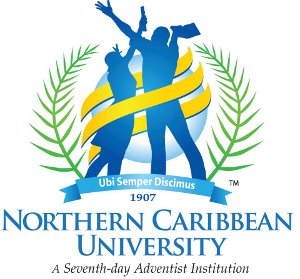
Northern Caribbean University (NCU) is a private, liberal-arts institution owned and operated by the Jamaica Union Conference (JMUC) and the Atlantic Caribbean Union (ATCU) of Seventh-day Adventists, and is located in Jamaica. With its main campus only 2 miles south of Mandeville town, in Manchester, and three other campuses situated in Kingston, Montego Bay and Salem Runaway Bay, St. Ann, the university offers a number of professional, pre-professional and vocational programmes in a spiritually wholesome and aesthetically pleasing atmosphere. Established in 1907, NCU currently enjoys an average yearly enrollment of over five thousand students, from up to 35 countries.

Education in Guyana is provided largely by the Government of Guyana, through the Ministry of Education and its arms in the ten different regions of the country. Guyana's education system is a legacy from its time as British Guiana, and is similar to that of the other anglophone member states of the Caribbean Community, which are affiliated to the Caribbean Examinations Council (CXC). School curricula, funding, standards and other policies are set by the central government and implemented through the Ministry of Education and related agencies. The Education System is divided into eleven districts, ten of which correspond to the national administrative and geographical regions of the country, while the capital, Georgetown, is treated as a separate education district, district 11. With 8.3% of its GDP spent on education, Guyana sits with Cuba, Iceland, Denmark and Botswana as among the few countries with top spending on education.
St. Mary High School is a secondary school located in the Highgate area of St Mary, Jamaica.

Calabar High School is an all-male secondary school in Kingston, Jamaica. It was established by the Jamaica Baptist Union in 1912 for the children of Baptist ministers. It was named after the Kalabari Kingdom later anglicized by the British to Calabar, in present-day Nigeria. It has produced at least five Rhodes Scholars, and is respected for its outstanding performance in track and field.
Education in Jamaica is primarily modeled on the British education system.

St. Elizabeth Technical High School (STETHS) is a co-educational secondary school in Santa Cruz, Saint Elizabeth, Jamaica. This year 2021 marks 25 years of STETHS Alumni Association (Inc.) and on 60 years since the inception of our alma mater. STETHS Alumni Association USA Inc. was formed and celebrated by STETHS Classes 1961 - 2020 and its President Donovan Wilson.
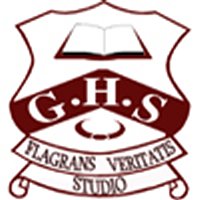
Glenmuir High School (GHS) is a Jamaican secondary school located in May Pen, Clarendon Parish, Jamaica. It is among the top performing secondary schools in the country. Glenmuir educates over 1,700 pupils, aged between 10 and 20 years. Glenmuir was founded in 1958 by the Rt. Reverend Percival William Gibson, the Bishop of Jamaica, as a private co-educational secondary school of the Anglican Diocese, on a 25-acre site in suburban May Pen. The school motto is "Flagrans Veritatis Studio".
Wolmer's Schools, also referred to as Wolmer's Trust Group of Schools in Kingston, Jamaica, currently consists of Wolmer's Pre-School, Wolmer's Preparatory School and two high schools: Wolmer's Trust High School For Girls and Wolmer's Trust High School for Boys. Both are schools of choice for many Jamaican students sitting Primary Exit Profile examinations. While acknowledged as separate institutions, each school shares a school song, crest, and motto, "Age Quod Agis", a Latin phrase that translates as "Whatever you do, do it well". Another English translation is “Whatever you do, do it to the best of your abilities”. Wolmer's Schools closely resemble British schools of the 1950s more than those today, a trend that can be noted of the entire Jamaican schooling system. Wolmer's Boys' and Girls' have been deemed some of the top schools in the Caribbean and performs well in exit examinations (CSEC/CAPE), especially in the Sciences and Mathematics.
Knox College is a co-educational high school for both day pupils and boarders in Clarendon Parish, Jamaica. The other institutions that form the complex are: the Neighbourhood Early Childhood Institute, Knox Junior School, and Knox Community College. It was co-founded by Rev. Dr. Lewis Davidson and Mr. David Bent in 1947 and is named after John Knox.
Ascot High School is a public Catholic secondary school, located in Kingston, Jamaica. The co-educational school was founded in 1997.
Saint Mary's College is a high school located in Above Rocks in Saint Catherine, Jamaica. It was founded in 1955 by its first principal, Father Edmund Cheney S.J. of St. Mary's Mission Catholic church.
Guy's Hill High School is a secondary school in the village of Guy's Hill, Saint Catherine, Jamaica. Established in 1971, the school serves students twelve to twenty years of age.
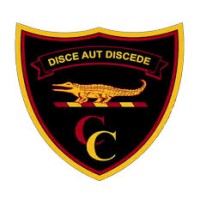
Cornwall College is a public high school for boys established in 1896 and located on Orange Street in Montego Bay, Saint James, Jamaica. It is the third oldest high school in the county of Cornwall. As of the 2022-23 school year, the school had an enrollment of just over 1,500 students and 80 classroom teachers, for a student–teacher ratio of 19:1.
York Castle High School is a co-educational secondary school in Jamaica. The school has educated some of the region's best leaders and it continues to play a pivotal role in Jamaica's development.
Titchfield High School is a secondary high school in Port Antonio, Jamaica, in the northern part of Portland Parish. The school was established in January 1786, and is the fifth-oldest high school in the country, after Wolmer's Boys', one of the Wolmer's Schools (1729), Manning's School (1738), St. Jago High School (1744), and Rusea's High School (1777). In the 18th century, these schools originated from their benefactors’ concerns for the education of the country’s poor, usually the children of poor whites, as there was no system in place for the education of the children of slaves.

Rusea's High School in Lucea, Hanover, Jamaica, established in 1777, is the fourth oldest, continuously operated high school in Jamaica, after Wolmer's Boys', one of the Wolmer's Schools (1729), Manning's School (1738) and St. Jago High School (1744).

